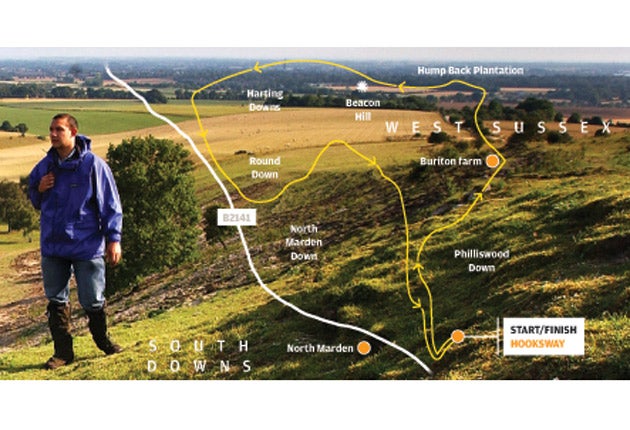Up with the skylarks on the South Downs
From lofty chalk hills to hushed woods and quiet valleys, Mark Rowe strides out in Britain's newest national park

It was a long time coming, but 53 years late, the South Downs is now to become a national park.
The original plan for designation was dismissed in 1956 but now the Downs, straddling Hampshire and Sussex, and stretching from Winchester to Eastbourne, have become the UK's 15th national park. This walk embraces something of the essence of the Downs, taking in a couple of locations popular with weekend trippers but also nosing around the quieter valleys and hushed woodlands.
The walk begins from a secluded pub, the Royal Oak, idyllically located in the village of Hooksway, seven miles north of Chichester. From the car park, make your way uphill for 400 yards and then take the chalky, sharp right-hand path. Keep on the main track around Germanleith Copse towards a white bungalow.
Here you reach a fork, where you take the right-hand route that becomes a winding path descending into a valley before climbing again. Keep ahead at the first junction of paths, but a few yards later, keep straight on, taking the right-hand, lower route through woodland again to emerge on a path leading to Buriton Farm. Walk through the farm and then take the first left-hand turn, signposted for the South Downs Way, on to a rising chalk track.
The path drops down to a copse where you follow South Downs Way markers to reach a crossroads. Here, keep ahead, but take the left-hand of two parallel tracks to make your way up Pen Hill, one of four short, steep climbs on this route. The views from the top are delightful, particularly to the east and north-east, with the chalky escarpments of the Downs melting away into the valleys and the Weald. This is the classic downs habitat – fragile chalk and clay, herb-rich downland meadows home to poppies and other wild flowers and butterflies, wooded hillsides and expanses of heathland with skylarks launching themselves upwards, bursting with song.
Drop down from Pen Hill and then take the right-hand fork up the steep track leading to the summit of Beacon Hill. This time, the views open up to the west, towards Winchester and south-west towards the coast, Hayling Island and East Head. To the north, the village of South Harting, with its green copper church spire, lies in a valley. Two parallel tracks run over Beacon Hill – the left-hand one leads to the viewing point.
To leave Beacon Hill, drop down sharply to the valley below, where you keep ahead and take either of the two prominent paths through gates that continue ahead over Round Down. The left-hand route gives more views of open country, but the paths converge again before reaching a wooden gate, with the ruined folly of Tower Hill perched conspicuously on a rise up to your right. Go through the gate and turn sharp left along the bridleway, walking slightly uphill and entering woodland.
Continue over a couple of tracks and, after half a mile, turn left along a path that joins from the B2141, prominently labelled as a public footpath, and go through the kissing gate. Follow this path, which runs just inside the edge of the copse, and keep on it as it swings left. The character of the woods alters dramatically: you are surrounded by darker yew trees as the path tumbles down to Bramshott Bottom.
As you emerge from cover at a crossing of paths, keep ahead, through the metal gate and tackle the short but stiff climb up Little Round Down. At the top, at a T-junction, you meet up with the South Downs Way again and turn right. Follow this path, passing through the large wooden gates and keeping ahead when the South Downs Way turns sharp left. The path soon becomes a metalled road as it passes Telegraph House, shaded by beech trees.
Where the road turns to the right, keep ahead, through a gate and past a white cottage to follow a footpath. This soon joins up with the first fork you encountered on the outward leg of the walk, and you keep ahead, retracing your steps back to the Royal Oak. Dating back more than 400 years, the pub, which has a lovely garden, represents a fine and welcoming end to the walk.
Compact Facts
Distance: Seven miles
Time: Four hours
OS Map: Explorer 120
How to get there
There's no bus service to Hooksway, so the best bet is a taxi from Chichester railway station. Mark Rowe stayed at Rubens Barn, a recently converted 300-year-old barn and five-star B&B (01243 818187; www.rubensbarn.co.uk; B&B costs £75 to £130 per bedroom per night). For dinner, another Royal Oak (01243 527434; royaloaklavant.co.uk), at East Lavant, is also recommended, four miles from Rubens Barn.
Further information
For more information on the area, go to visitchichester.org.
A version of this walk can be found in Family Days in the Countryside around Portsmouth and the South Downs, from Watergate Publishing.
Subscribe to Independent Premium to bookmark this article
Want to bookmark your favourite articles and stories to read or reference later? Start your Independent Premium subscription today.

Join our commenting forum
Join thought-provoking conversations, follow other Independent readers and see their replies